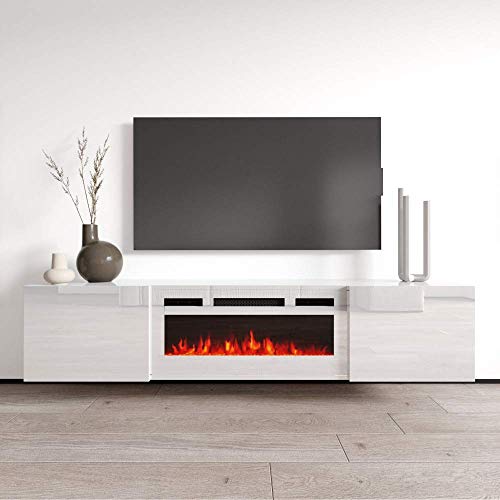What Bio Ethanol Fireplace Experts Would Like You To Know

Bio Ethanol Fireplaces
Ethanol fireplaces can provide warmth to any space, without the need for expensive construction or gas supply. They are the safest fireplace type that is available.
If you use bio-ethanol fuel that has been specifically designed for your fireplace and adhere to the safety guidelines, your fireplace should be safe to operate.
Easy installation
Ethanol fires are a simple and easy option for homeowners who wish to change the look of their living space or add a focal point to their home decor. They don't require a flue and don't create dangerous smoke and you don't have to worry about the build up of soot on your ceilings or walls.
Whether you opt for a full fire suite - like Mano Mano's Adam Solus Fireplace Suite in Oak with Colorado Bio Ethanol Fire in Black, available at PS569 - or an independent model that can be moved from room to room (such as the Planika Petit, PS191) Installation is easy and requires no specialist help. All you need to do is ensure that the wall or ceiling is sturdy enough and follow the directions for the specific model.
If you choose a wall-mounted ethanol fireplace Most come with the fittings that allow them to be mounted like a flat-screen TV, or installed into the wall. You'll need to find the studs and install the brackets and extensions however, it shouldn't take more than an hour for a professional to do so.
You can also pick between manual and automatic bioethanol burning devices. The automatic burner is designed to keep the fuel away from the flames, so that it can burn longer without the danger of overheating or running out. Manual burners function similar to fireplaces, but you will need matches or lighters in order to ignite the flames.
It is important to keep in mind that when selecting a bioethanol burner, the burner should be covered with non-combustible materials. This will ensure that nothing touches the burning fuel. If you do not cover the burner, the fire could overheat and damage the fireplace.
Ethanol fires are an excellent alternative for those who want to create a dramatic focal point in their home but don't have the funds or time to set up a wood or gas fireplace. These are ideal for renovations and new homes in which chimney breasts were removed. And, because they don't produce soot or ash, there aren't any maintenance issues to worry about or worry about.
Designs and styles
Bio ethanol fireplaces come in different styles and designs. Some bio ethanol fireplaces feature a traditional wood-burning look and others have modern and sleek designs. Each model offers the same advantages, regardless of design and ambiance free of harmful gasses or smoke.
Ethanol fireplaces can be freestanding or wall mounted. Freestanding models are more movable and can be moved around the room in any direction you like. Wall-mounted models, on other hand, are anchored to the wall and may require special mounting equipment. They also must comply with certain clearance distances to avoid flammable materials.
The fire is started through a burner pan, which is located at the bottom of the fireplace. Fuel is poured into the pan and the fire is lit by a long lighter. The process takes about 15 minutes to get the fire up to its maximum flame potential. Once the flames are set, it's time to relax, sit back and enjoy the warm atmosphere of your home.
Certain fireplaces with ethanol come with adjustable heat settings. This allows you to customize the amount of heat that your fireplace produces, which can be useful if you want it to give you more warmth than just ambiance.
Another benefit of ethanol fires is that there is no need for a chimney or flue. This makes them an excellent option for new homes or older ones that don't have traditional fireplaces or chimney breasts. Furthermore, a bio-ethanol fire place does not generate gas or ash, which can be dangerous for those suffering from respiratory issues.
Installing bioethanol fireplaces into your home is also simple. Although the exact time for installation depends on the model you choose the majority are installed in a short time. You can also opt for an open-air fireplace that you can carry with you when you decide to relocate, which makes it a great option to use as a temporary living arrangement. It is important to consider the ease of installation when purchasing an electric fireplace.
No Flu
The major advantage bio ethanol fires have over traditional gas or wood fires is that they don't need a flue in order to function. As a result, there's no chance of chimney fires that could result from a build-up of tar or obstructions in the flue.
A bio-ethanol fireplace doesn't produce many particles, which could harm the air. This is a great thing for people with asthma or allergies. The fireplace doesn't release smoke, therefore it does not create a bad odor in the room.
As opposed to a wood-burning fireplace a bio ethanol fire doesn't lose a lot of heat through the chimney, and therefore produces a huge amount of heat for its size. This means that you can keep your furniture in close proximity to the fire without worrying about catching fire, which could be dangerous for your valuables.
There are many designs to choose from for a bioethanol freestanding fireplace . You can go for a sleek and modern look with a wall-mounted model, or you can get a recessed version that will fit in with the style of your space.
A burner that is either manual or automated is a different option to consider. A manual burner requires that you light the fuel directly out of the reservoir. A burner that is automated will automatically light the fire once the tank is empty.
After you've used your bioethanol fireplace it is important to let the flames completely go out and wait until the fireplace has cooled before refueling. If you don't do this, the ethanol could evaporate and you'll have to start over.
Most manufacturers suggest waiting at least 45 minutes prior to refilling your fire. This will give you enough time to remove the flames, and to remove any flammable materials from the fire. In addition, it's recommended to store any remaining ethanol fuel somewhere out of reach of children and pets to prevent any accidents from occurring.

Maintenance ease
Ethanol fireplaces function by pouring bio ethanol fuel into the burner and lighting it. As the fuel burns, it generates the appearance of a flame and the heat can be controlled with an adjustable slider (not all designs include this feature). By altering the amount of oxygen fed to the fire, you can change the speed at which fuel burns and also the intensity of the flame.
As the fuel burns, it creates a small amount of soot. However, this can be easily cleaned by wiping the fireplace with a soft cloth. The only other maintenance required is to ensure that the fireplace is full of the correct fuel and making sure it is kept away from any flammable objects or equipment.
Bio ethanol fireplaces are also simple to install, and you don't have to worry about chimneys or building codes. This allows you to enjoy a vast amount of flexibility when it comes to designing your home, and also where you can experience the warmth and charm of your new fireplace. You could even choose to have a free-standing fireplace that can be moved from room to room.
Wall-mounted bioethanol fireplaces can be incorporated into walls easily, and certain models can be rotated by 180 degrees, allowing you to focus the heat and flame into the desired area of your room. You can even mount a remote control onto some designs to take full control from the couch.
Many wall-mounted bioethanol fireplaces come with brackets that allow them to be attached to a flat ceiling or an inclined one. This allows you to place the fireplace wherever you like it while being in a position to turn the flame off or on, adjust the flame height, and adjust the temperature using the remote control.
When you're not using your ethanol fireplace, be sure to shut it off and keep it away from any flammable items or materials. Don't try to pour additional fuel inside the burner until it has cooled to room temperature and always be careful when handling the burner since it will be very hot.
